Strategy Evaluation
VerifiedAdded on 2022/12/30
|14
|4192
|36
AI Summary
This report analyzes the strategy adopted by Tesco in the retail industry, focusing on the company overview, mission, vision, objectives, assessment of competitive advantage using the VRIO framework, application of the PESTLE framework to analyze the external environment, and application of Porter's Five Force Model to analyze the company. The report aims to provide insights into Tesco's strategy and suggest corrective measures to achieve its objectives effectively and efficiently.
Contribute Materials
Your contribution can guide someone’s learning journey. Share your
documents today.
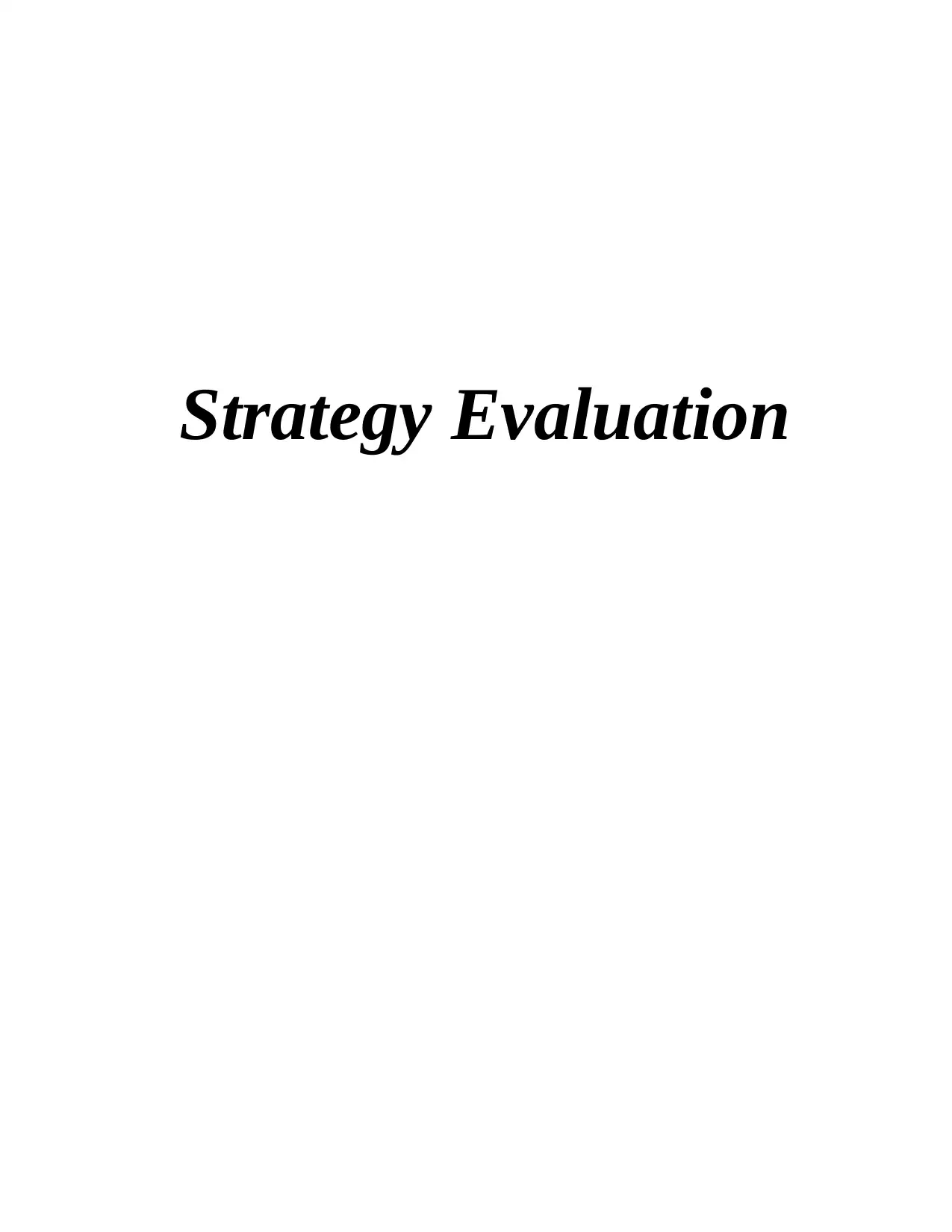
Strategy Evaluation
Secure Best Marks with AI Grader
Need help grading? Try our AI Grader for instant feedback on your assignments.
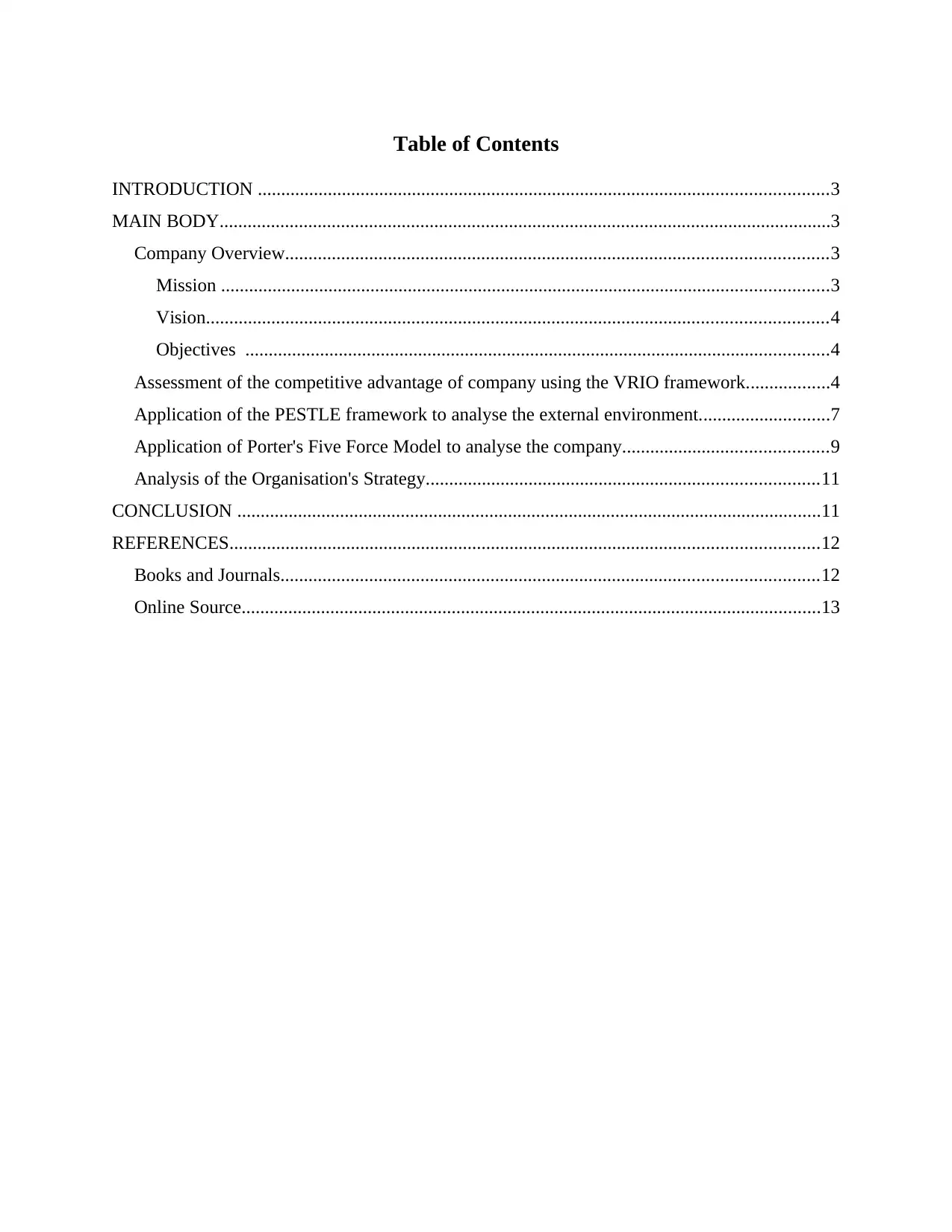
Table of Contents
INTRODUCTION ..........................................................................................................................3
MAIN BODY...................................................................................................................................3
Company Overview....................................................................................................................3
Mission ..................................................................................................................................3
Vision.....................................................................................................................................4
Objectives .............................................................................................................................4
Assessment of the competitive advantage of company using the VRIO framework..................4
Application of the PESTLE framework to analyse the external environment............................7
Application of Porter's Five Force Model to analyse the company............................................9
Analysis of the Organisation's Strategy....................................................................................11
CONCLUSION .............................................................................................................................11
REFERENCES..............................................................................................................................12
Books and Journals...................................................................................................................12
Online Source............................................................................................................................13
INTRODUCTION ..........................................................................................................................3
MAIN BODY...................................................................................................................................3
Company Overview....................................................................................................................3
Mission ..................................................................................................................................3
Vision.....................................................................................................................................4
Objectives .............................................................................................................................4
Assessment of the competitive advantage of company using the VRIO framework..................4
Application of the PESTLE framework to analyse the external environment............................7
Application of Porter's Five Force Model to analyse the company............................................9
Analysis of the Organisation's Strategy....................................................................................11
CONCLUSION .............................................................................................................................11
REFERENCES..............................................................................................................................12
Books and Journals...................................................................................................................12
Online Source............................................................................................................................13

INTRODUCTION
The term 'strategy' refers to plan of achieving the objectives so set for organisation.
Strategy provides the direction to achieve the goals and objectives. The term strategy analysis
refers to the series of steps taken to develop the strategy. The steps included in developing the
strategy includes critical analysis of internal and external factors, identification of the valuable
resources of the organisation which help them in gaining the competitive advantage and lastly
includes the analysis of the currents position of company by using various strategic management
tools such as SWOT, Porter's five force model etc. The steps so included helps in critical
evaluation of an organisation present standing in market and identifies the potential
opportunities and threats lying ahead. The aim of this report is to analyse the strategy adopted by
retail industry (Adewale, 2016). As, this industry has fluctuating micro and macro factors which
makes the organisation inefficient to achieve their objectives in this industry. The TESCO, is
been selected to review the strategy adopted by them to gain its objectives. TESCO, is one of the
giant retailer founded in 1919, with headquarters in UK. This report will cover the analysis of
strategy and directing the corrective plan that will help them to achieve their stipulated objective
effectively and efficiently.
MAIN BODY
Company Overview
TESCO is global leader in the retailing industry with roots across all globe. The company
was founded by Jack Cohen in,1919. After 1960, the company has seen the huge success by
diversifying its product portfolio and by expanding is market rapidly. The company is listed on
London Stock Exchange, with market cap of £18.1billion (Denning, 2017) . The company
product range consist of food items, telecommunications and financial services. As, compared to
the Tesco's position in UK market is losing its share in comparison to competitors. The
evaluation of the strategy adopted by Tesco is being analysed.
Mission
The Tesco, mission states that they believe in making what is better and valuable. The
integrity is the core principle in achieving this.
The term 'strategy' refers to plan of achieving the objectives so set for organisation.
Strategy provides the direction to achieve the goals and objectives. The term strategy analysis
refers to the series of steps taken to develop the strategy. The steps included in developing the
strategy includes critical analysis of internal and external factors, identification of the valuable
resources of the organisation which help them in gaining the competitive advantage and lastly
includes the analysis of the currents position of company by using various strategic management
tools such as SWOT, Porter's five force model etc. The steps so included helps in critical
evaluation of an organisation present standing in market and identifies the potential
opportunities and threats lying ahead. The aim of this report is to analyse the strategy adopted by
retail industry (Adewale, 2016). As, this industry has fluctuating micro and macro factors which
makes the organisation inefficient to achieve their objectives in this industry. The TESCO, is
been selected to review the strategy adopted by them to gain its objectives. TESCO, is one of the
giant retailer founded in 1919, with headquarters in UK. This report will cover the analysis of
strategy and directing the corrective plan that will help them to achieve their stipulated objective
effectively and efficiently.
MAIN BODY
Company Overview
TESCO is global leader in the retailing industry with roots across all globe. The company
was founded by Jack Cohen in,1919. After 1960, the company has seen the huge success by
diversifying its product portfolio and by expanding is market rapidly. The company is listed on
London Stock Exchange, with market cap of £18.1billion (Denning, 2017) . The company
product range consist of food items, telecommunications and financial services. As, compared to
the Tesco's position in UK market is losing its share in comparison to competitors. The
evaluation of the strategy adopted by Tesco is being analysed.
Mission
The Tesco, mission states that they believe in making what is better and valuable. The
integrity is the core principle in achieving this.
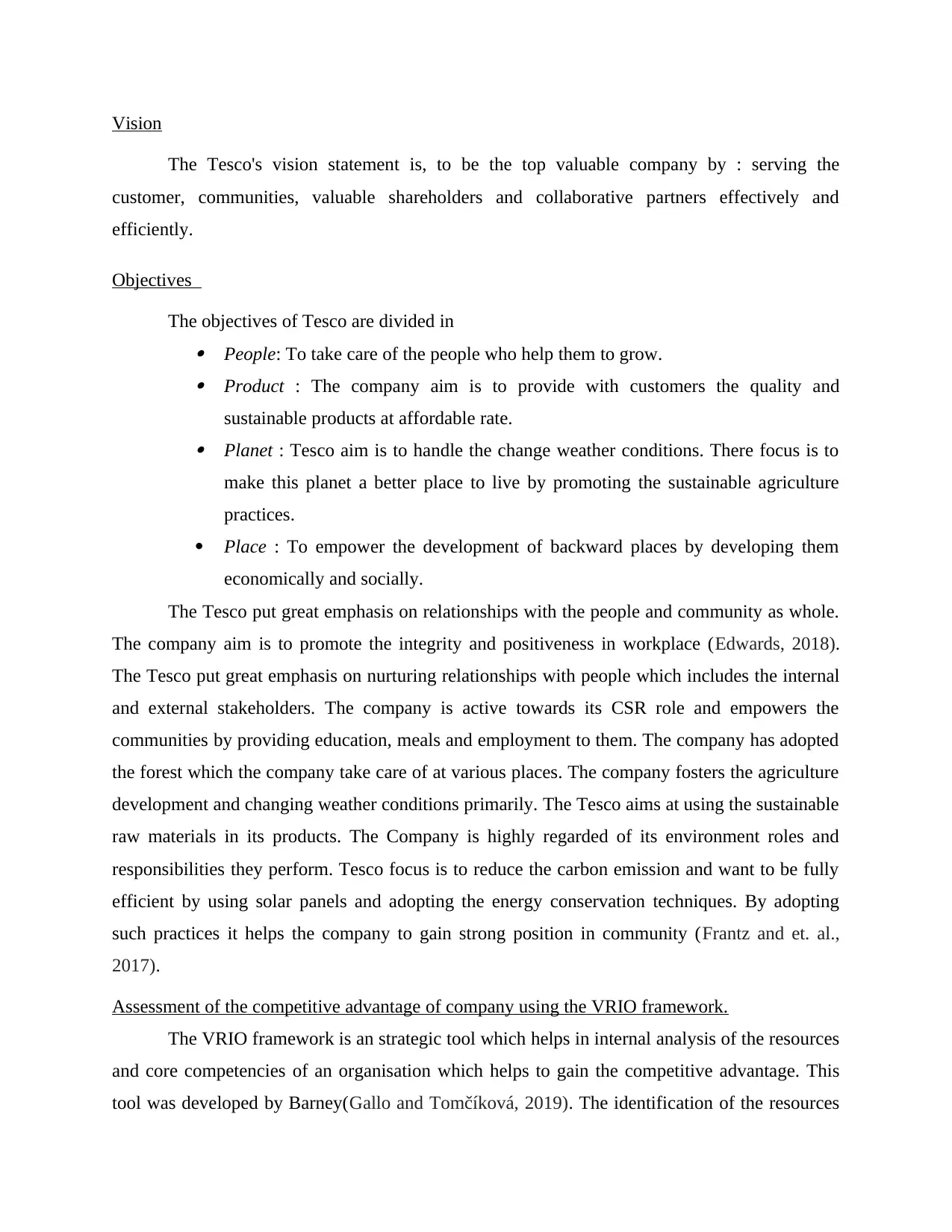
Vision
The Tesco's vision statement is, to be the top valuable company by : serving the
customer, communities, valuable shareholders and collaborative partners effectively and
efficiently.
Objectives
The objectives of Tesco are divided in
People: To take care of the people who help them to grow.
Product : The company aim is to provide with customers the quality and
sustainable products at affordable rate.
Planet : Tesco aim is to handle the change weather conditions. There focus is to
make this planet a better place to live by promoting the sustainable agriculture
practices.
Place : To empower the development of backward places by developing them
economically and socially.
The Tesco put great emphasis on relationships with the people and community as whole.
The company aim is to promote the integrity and positiveness in workplace (Edwards, 2018).
The Tesco put great emphasis on nurturing relationships with people which includes the internal
and external stakeholders. The company is active towards its CSR role and empowers the
communities by providing education, meals and employment to them. The company has adopted
the forest which the company take care of at various places. The company fosters the agriculture
development and changing weather conditions primarily. The Tesco aims at using the sustainable
raw materials in its products. The Company is highly regarded of its environment roles and
responsibilities they perform. Tesco focus is to reduce the carbon emission and want to be fully
efficient by using solar panels and adopting the energy conservation techniques. By adopting
such practices it helps the company to gain strong position in community (Frantz and et. al.,
2017).
Assessment of the competitive advantage of company using the VRIO framework.
The VRIO framework is an strategic tool which helps in internal analysis of the resources
and core competencies of an organisation which helps to gain the competitive advantage. This
tool was developed by Barney(Gallo and Tomčíková, 2019). The identification of the resources
The Tesco's vision statement is, to be the top valuable company by : serving the
customer, communities, valuable shareholders and collaborative partners effectively and
efficiently.
Objectives
The objectives of Tesco are divided in
People: To take care of the people who help them to grow.
Product : The company aim is to provide with customers the quality and
sustainable products at affordable rate.
Planet : Tesco aim is to handle the change weather conditions. There focus is to
make this planet a better place to live by promoting the sustainable agriculture
practices.
Place : To empower the development of backward places by developing them
economically and socially.
The Tesco put great emphasis on relationships with the people and community as whole.
The company aim is to promote the integrity and positiveness in workplace (Edwards, 2018).
The Tesco put great emphasis on nurturing relationships with people which includes the internal
and external stakeholders. The company is active towards its CSR role and empowers the
communities by providing education, meals and employment to them. The company has adopted
the forest which the company take care of at various places. The company fosters the agriculture
development and changing weather conditions primarily. The Tesco aims at using the sustainable
raw materials in its products. The Company is highly regarded of its environment roles and
responsibilities they perform. Tesco focus is to reduce the carbon emission and want to be fully
efficient by using solar panels and adopting the energy conservation techniques. By adopting
such practices it helps the company to gain strong position in community (Frantz and et. al.,
2017).
Assessment of the competitive advantage of company using the VRIO framework.
The VRIO framework is an strategic tool which helps in internal analysis of the resources
and core competencies of an organisation which helps to gain the competitive advantage. This
tool was developed by Barney(Gallo and Tomčíková, 2019). The identification of the resources
Paraphrase This Document
Need a fresh take? Get an instant paraphrase of this document with our AI Paraphraser
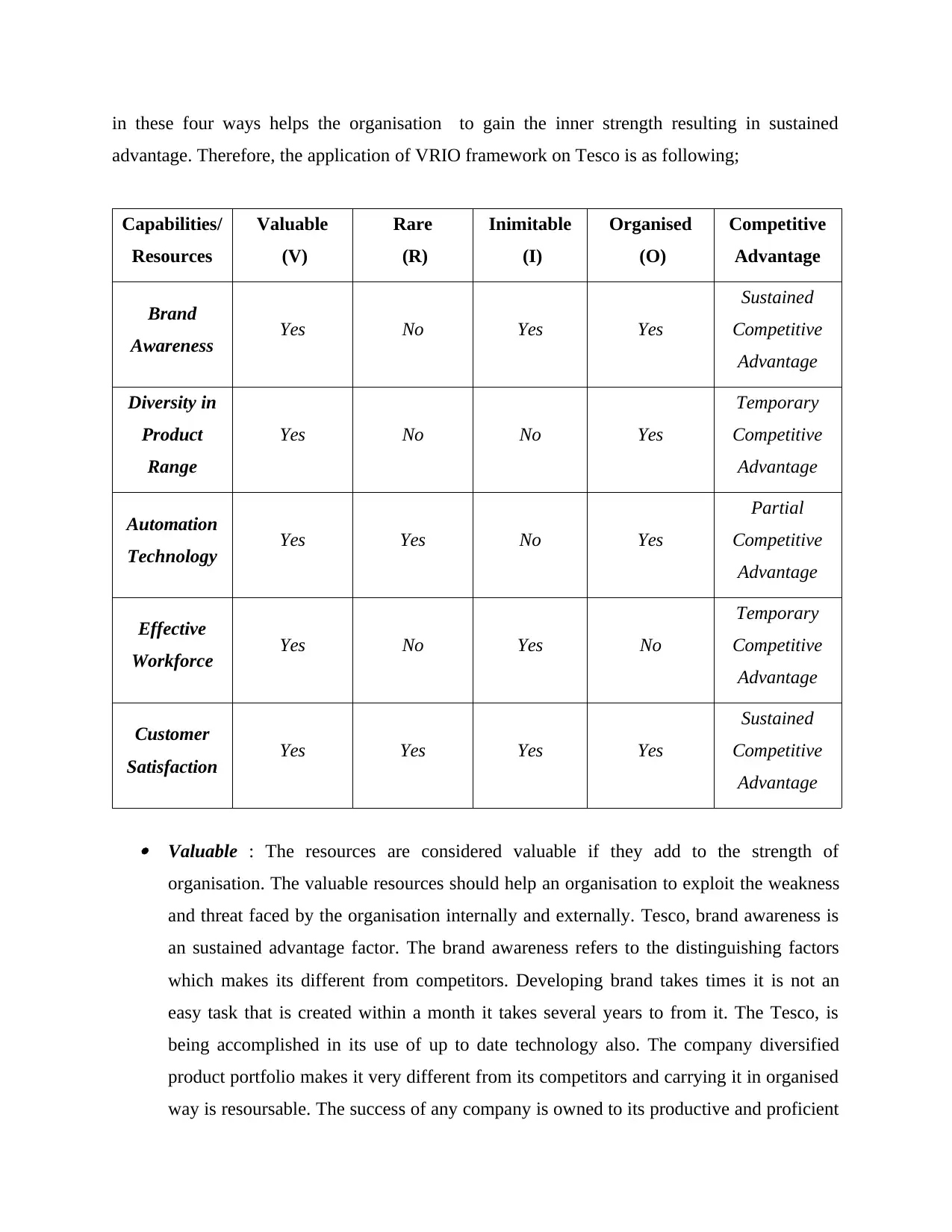
in these four ways helps the organisation to gain the inner strength resulting in sustained
advantage. Therefore, the application of VRIO framework on Tesco is as following;
Capabilities/
Resources
Valuable
(V)
Rare
(R)
Inimitable
(I)
Organised
(O)
Competitive
Advantage
Brand
Awareness Yes No Yes Yes
Sustained
Competitive
Advantage
Diversity in
Product
Range
Yes No No Yes
Temporary
Competitive
Advantage
Automation
Technology Yes Yes No Yes
Partial
Competitive
Advantage
Effective
Workforce Yes No Yes No
Temporary
Competitive
Advantage
Customer
Satisfaction Yes Yes Yes Yes
Sustained
Competitive
Advantage
Valuable : The resources are considered valuable if they add to the strength of
organisation. The valuable resources should help an organisation to exploit the weakness
and threat faced by the organisation internally and externally. Tesco, brand awareness is
an sustained advantage factor. The brand awareness refers to the distinguishing factors
which makes its different from competitors. Developing brand takes times it is not an
easy task that is created within a month it takes several years to from it. The Tesco, is
being accomplished in its use of up to date technology also. The company diversified
product portfolio makes it very different from its competitors and carrying it in organised
way is resoursable. The success of any company is owned to its productive and proficient
advantage. Therefore, the application of VRIO framework on Tesco is as following;
Capabilities/
Resources
Valuable
(V)
Rare
(R)
Inimitable
(I)
Organised
(O)
Competitive
Advantage
Brand
Awareness Yes No Yes Yes
Sustained
Competitive
Advantage
Diversity in
Product
Range
Yes No No Yes
Temporary
Competitive
Advantage
Automation
Technology Yes Yes No Yes
Partial
Competitive
Advantage
Effective
Workforce Yes No Yes No
Temporary
Competitive
Advantage
Customer
Satisfaction Yes Yes Yes Yes
Sustained
Competitive
Advantage
Valuable : The resources are considered valuable if they add to the strength of
organisation. The valuable resources should help an organisation to exploit the weakness
and threat faced by the organisation internally and externally. Tesco, brand awareness is
an sustained advantage factor. The brand awareness refers to the distinguishing factors
which makes its different from competitors. Developing brand takes times it is not an
easy task that is created within a month it takes several years to from it. The Tesco, is
being accomplished in its use of up to date technology also. The company diversified
product portfolio makes it very different from its competitors and carrying it in organised
way is resoursable. The success of any company is owned to its productive and proficient
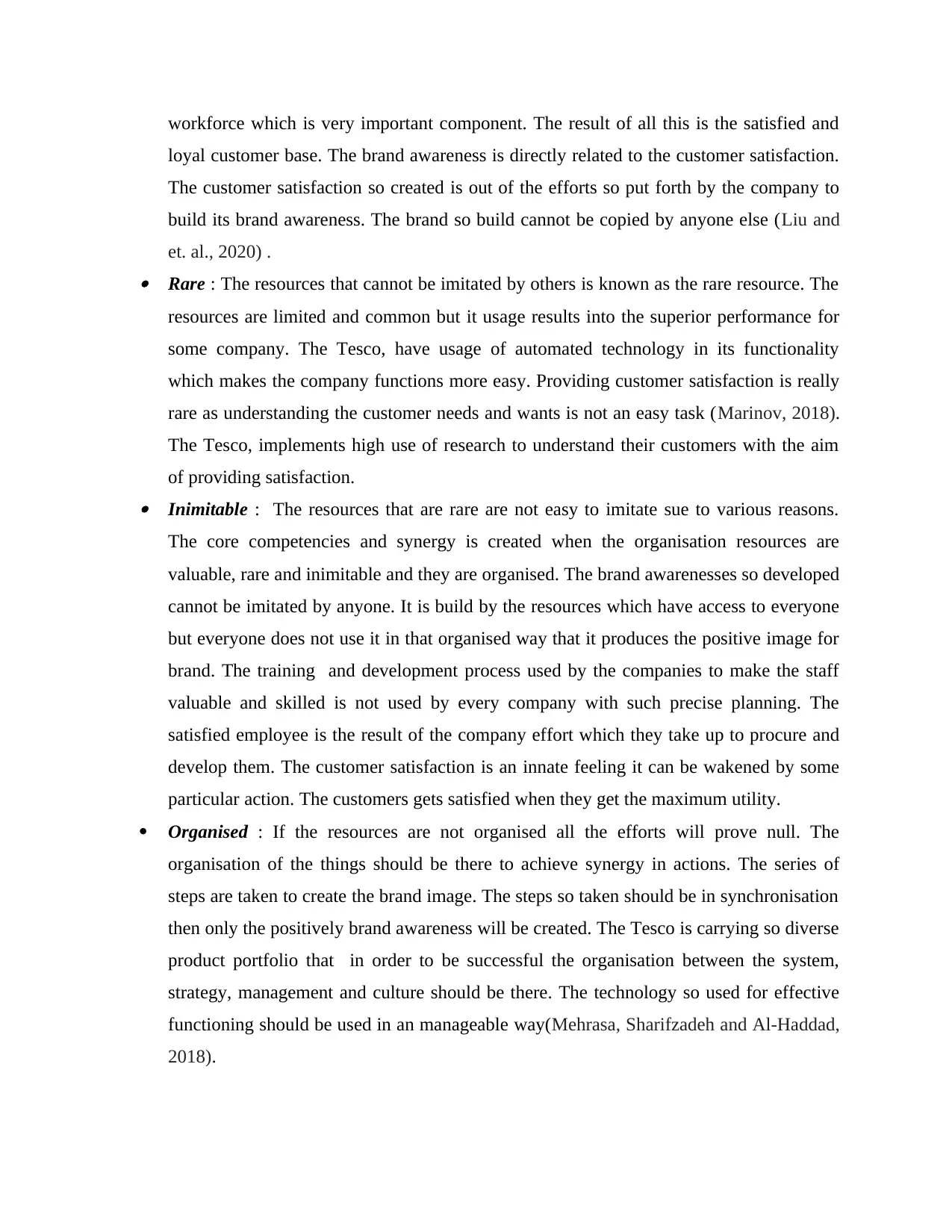
workforce which is very important component. The result of all this is the satisfied and
loyal customer base. The brand awareness is directly related to the customer satisfaction.
The customer satisfaction so created is out of the efforts so put forth by the company to
build its brand awareness. The brand so build cannot be copied by anyone else (Liu and
et. al., 2020) . Rare : The resources that cannot be imitated by others is known as the rare resource. The
resources are limited and common but it usage results into the superior performance for
some company. The Tesco, have usage of automated technology in its functionality
which makes the company functions more easy. Providing customer satisfaction is really
rare as understanding the customer needs and wants is not an easy task (Marinov, 2018).
The Tesco, implements high use of research to understand their customers with the aim
of providing satisfaction. Inimitable : The resources that are rare are not easy to imitate sue to various reasons.
The core competencies and synergy is created when the organisation resources are
valuable, rare and inimitable and they are organised. The brand awarenesses so developed
cannot be imitated by anyone. It is build by the resources which have access to everyone
but everyone does not use it in that organised way that it produces the positive image for
brand. The training and development process used by the companies to make the staff
valuable and skilled is not used by every company with such precise planning. The
satisfied employee is the result of the company effort which they take up to procure and
develop them. The customer satisfaction is an innate feeling it can be wakened by some
particular action. The customers gets satisfied when they get the maximum utility.
Organised : If the resources are not organised all the efforts will prove null. The
organisation of the things should be there to achieve synergy in actions. The series of
steps are taken to create the brand image. The steps so taken should be in synchronisation
then only the positively brand awareness will be created. The Tesco is carrying so diverse
product portfolio that in order to be successful the organisation between the system,
strategy, management and culture should be there. The technology so used for effective
functioning should be used in an manageable way(Mehrasa, Sharifzadeh and Al-Haddad,
2018).
loyal customer base. The brand awareness is directly related to the customer satisfaction.
The customer satisfaction so created is out of the efforts so put forth by the company to
build its brand awareness. The brand so build cannot be copied by anyone else (Liu and
et. al., 2020) . Rare : The resources that cannot be imitated by others is known as the rare resource. The
resources are limited and common but it usage results into the superior performance for
some company. The Tesco, have usage of automated technology in its functionality
which makes the company functions more easy. Providing customer satisfaction is really
rare as understanding the customer needs and wants is not an easy task (Marinov, 2018).
The Tesco, implements high use of research to understand their customers with the aim
of providing satisfaction. Inimitable : The resources that are rare are not easy to imitate sue to various reasons.
The core competencies and synergy is created when the organisation resources are
valuable, rare and inimitable and they are organised. The brand awarenesses so developed
cannot be imitated by anyone. It is build by the resources which have access to everyone
but everyone does not use it in that organised way that it produces the positive image for
brand. The training and development process used by the companies to make the staff
valuable and skilled is not used by every company with such precise planning. The
satisfied employee is the result of the company effort which they take up to procure and
develop them. The customer satisfaction is an innate feeling it can be wakened by some
particular action. The customers gets satisfied when they get the maximum utility.
Organised : If the resources are not organised all the efforts will prove null. The
organisation of the things should be there to achieve synergy in actions. The series of
steps are taken to create the brand image. The steps so taken should be in synchronisation
then only the positively brand awareness will be created. The Tesco is carrying so diverse
product portfolio that in order to be successful the organisation between the system,
strategy, management and culture should be there. The technology so used for effective
functioning should be used in an manageable way(Mehrasa, Sharifzadeh and Al-Haddad,
2018).

The VRIO of Tesco resulted in knowing the strength of the resources installed by the
organisation. The company can achieve the sustained advantage only when the company deploys
it resources in productive manner such that it achieve the strong standing in comparison to it
competitors. The Tesco should always be in opportunity to find the rare resources which it can
use as capability. The constant review of the resources should be done as it changes over the
time.
Application of the PESTLE framework to analyse the external environment.
The analysis of the macro factors help in knowing the opportunities and threats lying
ahead for an organisation. The analysis of Tesco macro factors is as follows; Political : The Tesco being the global leader should keep the bird's eye view on the
changing political scenario to continue its effectiveness in operations. The company large
served area is UK and that country posses the strong political stability which results in
less corruption and transparency in the operations. The Tesco is being affected by the
Brexit largely. As, the company have supplies from all across the globe the UK
withdrawal from European Union has resulted in increased restriction such as high import
duties putting the high financial pressure on the company (Naipinit, Sakolnakorn and
Kroeksakul, 2016). Such restrictions affect the profitability of company resulting in
increase in prices. Economic : The Economic environment affects largely the company's operation. The
Tesco being operating in various countries have major pressure to understand precisely
each country's tax structure, spending patterns of people etc. As, every country ha its own
tax structure thus complying with it should be the focus. The UK's economic
environment is unstable during nowadays because of the Coronavirus impact. The
pandemic resulted in high unemployment and reduced purchasing power of people. This
impacted the Tesco operation largely. Because of this the company was forced to do lay
off's and cut down the prices and survive in this course. The all over economic
environment was impacted and its getting back on track slowly. Social : The socio cultural factors are changing rapidly. These factors give an
understanding of the demographics, behaviour and psycographic preferences of an
society. The thorough understanding of these factors should be with the company as these
help in understanding the consumers needs clearly (Novikov, 2018). Every region in
organisation. The company can achieve the sustained advantage only when the company deploys
it resources in productive manner such that it achieve the strong standing in comparison to it
competitors. The Tesco should always be in opportunity to find the rare resources which it can
use as capability. The constant review of the resources should be done as it changes over the
time.
Application of the PESTLE framework to analyse the external environment.
The analysis of the macro factors help in knowing the opportunities and threats lying
ahead for an organisation. The analysis of Tesco macro factors is as follows; Political : The Tesco being the global leader should keep the bird's eye view on the
changing political scenario to continue its effectiveness in operations. The company large
served area is UK and that country posses the strong political stability which results in
less corruption and transparency in the operations. The Tesco is being affected by the
Brexit largely. As, the company have supplies from all across the globe the UK
withdrawal from European Union has resulted in increased restriction such as high import
duties putting the high financial pressure on the company (Naipinit, Sakolnakorn and
Kroeksakul, 2016). Such restrictions affect the profitability of company resulting in
increase in prices. Economic : The Economic environment affects largely the company's operation. The
Tesco being operating in various countries have major pressure to understand precisely
each country's tax structure, spending patterns of people etc. As, every country ha its own
tax structure thus complying with it should be the focus. The UK's economic
environment is unstable during nowadays because of the Coronavirus impact. The
pandemic resulted in high unemployment and reduced purchasing power of people. This
impacted the Tesco operation largely. Because of this the company was forced to do lay
off's and cut down the prices and survive in this course. The all over economic
environment was impacted and its getting back on track slowly. Social : The socio cultural factors are changing rapidly. These factors give an
understanding of the demographics, behaviour and psycographic preferences of an
society. The thorough understanding of these factors should be with the company as these
help in understanding the consumers needs clearly (Novikov, 2018). Every region in
Secure Best Marks with AI Grader
Need help grading? Try our AI Grader for instant feedback on your assignments.
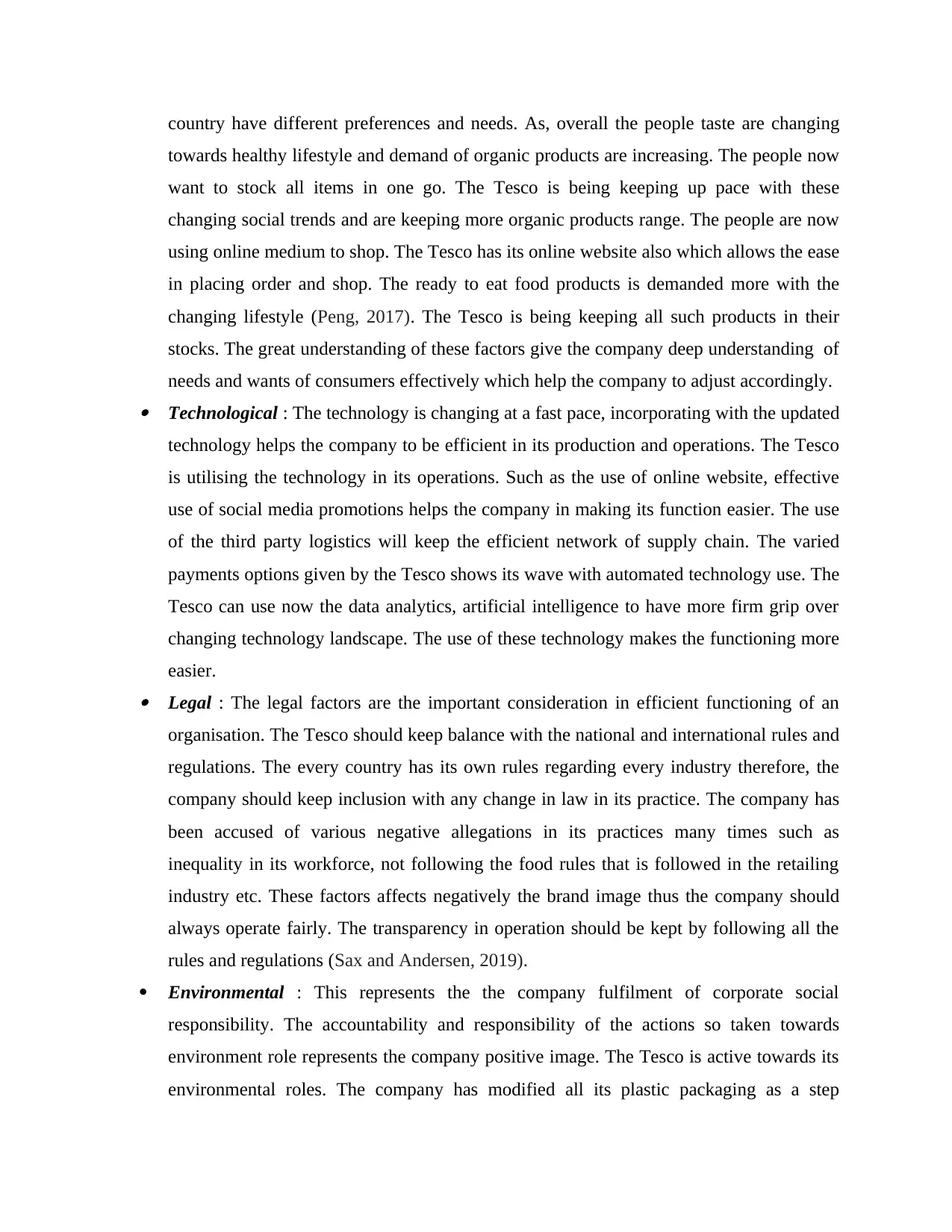
country have different preferences and needs. As, overall the people taste are changing
towards healthy lifestyle and demand of organic products are increasing. The people now
want to stock all items in one go. The Tesco is being keeping up pace with these
changing social trends and are keeping more organic products range. The people are now
using online medium to shop. The Tesco has its online website also which allows the ease
in placing order and shop. The ready to eat food products is demanded more with the
changing lifestyle (Peng, 2017). The Tesco is being keeping all such products in their
stocks. The great understanding of these factors give the company deep understanding of
needs and wants of consumers effectively which help the company to adjust accordingly. Technological : The technology is changing at a fast pace, incorporating with the updated
technology helps the company to be efficient in its production and operations. The Tesco
is utilising the technology in its operations. Such as the use of online website, effective
use of social media promotions helps the company in making its function easier. The use
of the third party logistics will keep the efficient network of supply chain. The varied
payments options given by the Tesco shows its wave with automated technology use. The
Tesco can use now the data analytics, artificial intelligence to have more firm grip over
changing technology landscape. The use of these technology makes the functioning more
easier. Legal : The legal factors are the important consideration in efficient functioning of an
organisation. The Tesco should keep balance with the national and international rules and
regulations. The every country has its own rules regarding every industry therefore, the
company should keep inclusion with any change in law in its practice. The company has
been accused of various negative allegations in its practices many times such as
inequality in its workforce, not following the food rules that is followed in the retailing
industry etc. These factors affects negatively the brand image thus the company should
always operate fairly. The transparency in operation should be kept by following all the
rules and regulations (Sax and Andersen, 2019).
Environmental : This represents the the company fulfilment of corporate social
responsibility. The accountability and responsibility of the actions so taken towards
environment role represents the company positive image. The Tesco is active towards its
environmental roles. The company has modified all its plastic packaging as a step
towards healthy lifestyle and demand of organic products are increasing. The people now
want to stock all items in one go. The Tesco is being keeping up pace with these
changing social trends and are keeping more organic products range. The people are now
using online medium to shop. The Tesco has its online website also which allows the ease
in placing order and shop. The ready to eat food products is demanded more with the
changing lifestyle (Peng, 2017). The Tesco is being keeping all such products in their
stocks. The great understanding of these factors give the company deep understanding of
needs and wants of consumers effectively which help the company to adjust accordingly. Technological : The technology is changing at a fast pace, incorporating with the updated
technology helps the company to be efficient in its production and operations. The Tesco
is utilising the technology in its operations. Such as the use of online website, effective
use of social media promotions helps the company in making its function easier. The use
of the third party logistics will keep the efficient network of supply chain. The varied
payments options given by the Tesco shows its wave with automated technology use. The
Tesco can use now the data analytics, artificial intelligence to have more firm grip over
changing technology landscape. The use of these technology makes the functioning more
easier. Legal : The legal factors are the important consideration in efficient functioning of an
organisation. The Tesco should keep balance with the national and international rules and
regulations. The every country has its own rules regarding every industry therefore, the
company should keep inclusion with any change in law in its practice. The company has
been accused of various negative allegations in its practices many times such as
inequality in its workforce, not following the food rules that is followed in the retailing
industry etc. These factors affects negatively the brand image thus the company should
always operate fairly. The transparency in operation should be kept by following all the
rules and regulations (Sax and Andersen, 2019).
Environmental : This represents the the company fulfilment of corporate social
responsibility. The accountability and responsibility of the actions so taken towards
environment role represents the company positive image. The Tesco is active towards its
environmental roles. The company has modified all its plastic packaging as a step
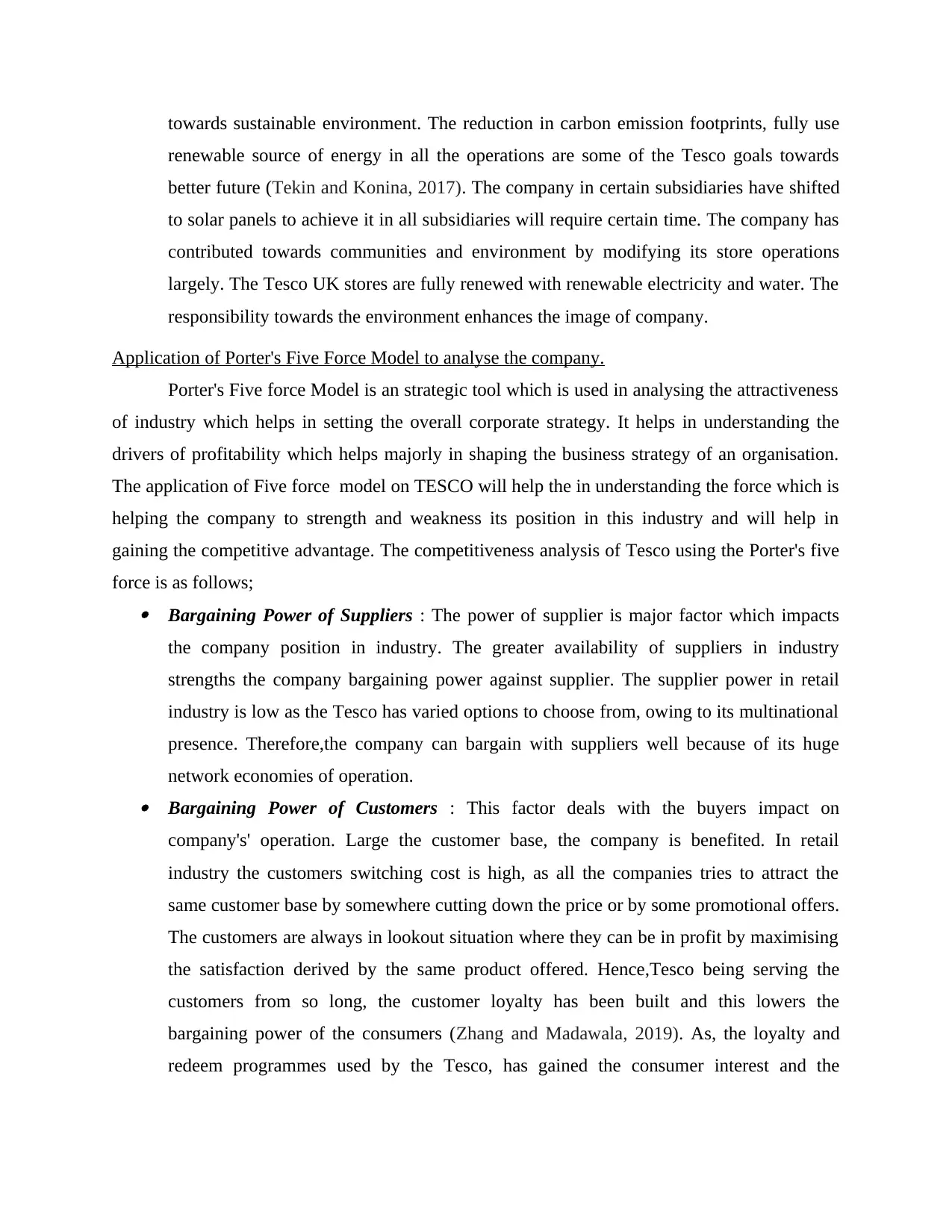
towards sustainable environment. The reduction in carbon emission footprints, fully use
renewable source of energy in all the operations are some of the Tesco goals towards
better future (Tekin and Konina, 2017). The company in certain subsidiaries have shifted
to solar panels to achieve it in all subsidiaries will require certain time. The company has
contributed towards communities and environment by modifying its store operations
largely. The Tesco UK stores are fully renewed with renewable electricity and water. The
responsibility towards the environment enhances the image of company.
Application of Porter's Five Force Model to analyse the company.
Porter's Five force Model is an strategic tool which is used in analysing the attractiveness
of industry which helps in setting the overall corporate strategy. It helps in understanding the
drivers of profitability which helps majorly in shaping the business strategy of an organisation.
The application of Five force model on TESCO will help the in understanding the force which is
helping the company to strength and weakness its position in this industry and will help in
gaining the competitive advantage. The competitiveness analysis of Tesco using the Porter's five
force is as follows; Bargaining Power of Suppliers : The power of supplier is major factor which impacts
the company position in industry. The greater availability of suppliers in industry
strengths the company bargaining power against supplier. The supplier power in retail
industry is low as the Tesco has varied options to choose from, owing to its multinational
presence. Therefore,the company can bargain with suppliers well because of its huge
network economies of operation. Bargaining Power of Customers : This factor deals with the buyers impact on
company's' operation. Large the customer base, the company is benefited. In retail
industry the customers switching cost is high, as all the companies tries to attract the
same customer base by somewhere cutting down the price or by some promotional offers.
The customers are always in lookout situation where they can be in profit by maximising
the satisfaction derived by the same product offered. Hence,Tesco being serving the
customers from so long, the customer loyalty has been built and this lowers the
bargaining power of the consumers (Zhang and Madawala, 2019). As, the loyalty and
redeem programmes used by the Tesco, has gained the consumer interest and the
renewable source of energy in all the operations are some of the Tesco goals towards
better future (Tekin and Konina, 2017). The company in certain subsidiaries have shifted
to solar panels to achieve it in all subsidiaries will require certain time. The company has
contributed towards communities and environment by modifying its store operations
largely. The Tesco UK stores are fully renewed with renewable electricity and water. The
responsibility towards the environment enhances the image of company.
Application of Porter's Five Force Model to analyse the company.
Porter's Five force Model is an strategic tool which is used in analysing the attractiveness
of industry which helps in setting the overall corporate strategy. It helps in understanding the
drivers of profitability which helps majorly in shaping the business strategy of an organisation.
The application of Five force model on TESCO will help the in understanding the force which is
helping the company to strength and weakness its position in this industry and will help in
gaining the competitive advantage. The competitiveness analysis of Tesco using the Porter's five
force is as follows; Bargaining Power of Suppliers : The power of supplier is major factor which impacts
the company position in industry. The greater availability of suppliers in industry
strengths the company bargaining power against supplier. The supplier power in retail
industry is low as the Tesco has varied options to choose from, owing to its multinational
presence. Therefore,the company can bargain with suppliers well because of its huge
network economies of operation. Bargaining Power of Customers : This factor deals with the buyers impact on
company's' operation. Large the customer base, the company is benefited. In retail
industry the customers switching cost is high, as all the companies tries to attract the
same customer base by somewhere cutting down the price or by some promotional offers.
The customers are always in lookout situation where they can be in profit by maximising
the satisfaction derived by the same product offered. Hence,Tesco being serving the
customers from so long, the customer loyalty has been built and this lowers the
bargaining power of the consumers (Zhang and Madawala, 2019). As, the loyalty and
redeem programmes used by the Tesco, has gained the consumer interest and the

company should should continue with such effective programmes that will affect the
switching cost of customers, resulting to increased revenue of Tesco. Threat of new entrants : The industry will attract the new players if the barriers to entry
is low and technology is easily available. To strengthen the position in industry, the
barriers should be set that will help the existing players to divide the share fairly. The
threat of new entrants is low in retailing industry, as Tesco have been in this industry for
over years. The company has the advantage of economies of scale and have fair core
competencies which is required to have strong standing in market. The entrance of the
new gigs will take time to establish and acquire that position. The Tesco should continue
to innovate its product lines and operation that will helps the company to maintain and
increase their share in market. The continuous renovation of the stores and diversification
of product portfolio will help the company to continue the success enjoyed for so long. Threat of Substitutes : The substitution effect is the result of finding the same product or
the closest of it easily in market. The Tesco, sells majorly all the products and its
substitutes also. The threat of substitutes is low, as with the emergence of small retailers
also the operations of Tesco would not affected. The reason being is the Tesco's own
serving has varied options. The Tesco can even increase the switching cost for customers
which will affect the company positively.
Competitive Rivalry : This is the presence of the competitors in the industry and their
position in respect of our company. This factor highly impact on Tesco, as the existing
companies use aggressive marketing and promotional tactics to maintain their position.
The Tesco also uses the various tactics to maintain their market presence against their
competitors. The Tesco biggest competitors are Sansbury, Asda etc. as the consistent
price cuts, promotional campaigns are runned simultaneously be the companies to capture
more market share. The Tesco for maintaining and expanding the market should apply
new promotional tactics and should continue to offer innovations in existing products and
services. The effort should be greater to maintain and satisfy the existing share of
customers. The differentiation should be invented in operations to serve the customers.
Even the company go for market expansion strategies such as mergers and acquisition to
effectively increase their market share and have edge over competitors (Zheng and Wang,
2017).
switching cost of customers, resulting to increased revenue of Tesco. Threat of new entrants : The industry will attract the new players if the barriers to entry
is low and technology is easily available. To strengthen the position in industry, the
barriers should be set that will help the existing players to divide the share fairly. The
threat of new entrants is low in retailing industry, as Tesco have been in this industry for
over years. The company has the advantage of economies of scale and have fair core
competencies which is required to have strong standing in market. The entrance of the
new gigs will take time to establish and acquire that position. The Tesco should continue
to innovate its product lines and operation that will helps the company to maintain and
increase their share in market. The continuous renovation of the stores and diversification
of product portfolio will help the company to continue the success enjoyed for so long. Threat of Substitutes : The substitution effect is the result of finding the same product or
the closest of it easily in market. The Tesco, sells majorly all the products and its
substitutes also. The threat of substitutes is low, as with the emergence of small retailers
also the operations of Tesco would not affected. The reason being is the Tesco's own
serving has varied options. The Tesco can even increase the switching cost for customers
which will affect the company positively.
Competitive Rivalry : This is the presence of the competitors in the industry and their
position in respect of our company. This factor highly impact on Tesco, as the existing
companies use aggressive marketing and promotional tactics to maintain their position.
The Tesco also uses the various tactics to maintain their market presence against their
competitors. The Tesco biggest competitors are Sansbury, Asda etc. as the consistent
price cuts, promotional campaigns are runned simultaneously be the companies to capture
more market share. The Tesco for maintaining and expanding the market should apply
new promotional tactics and should continue to offer innovations in existing products and
services. The effort should be greater to maintain and satisfy the existing share of
customers. The differentiation should be invented in operations to serve the customers.
Even the company go for market expansion strategies such as mergers and acquisition to
effectively increase their market share and have edge over competitors (Zheng and Wang,
2017).
Paraphrase This Document
Need a fresh take? Get an instant paraphrase of this document with our AI Paraphraser
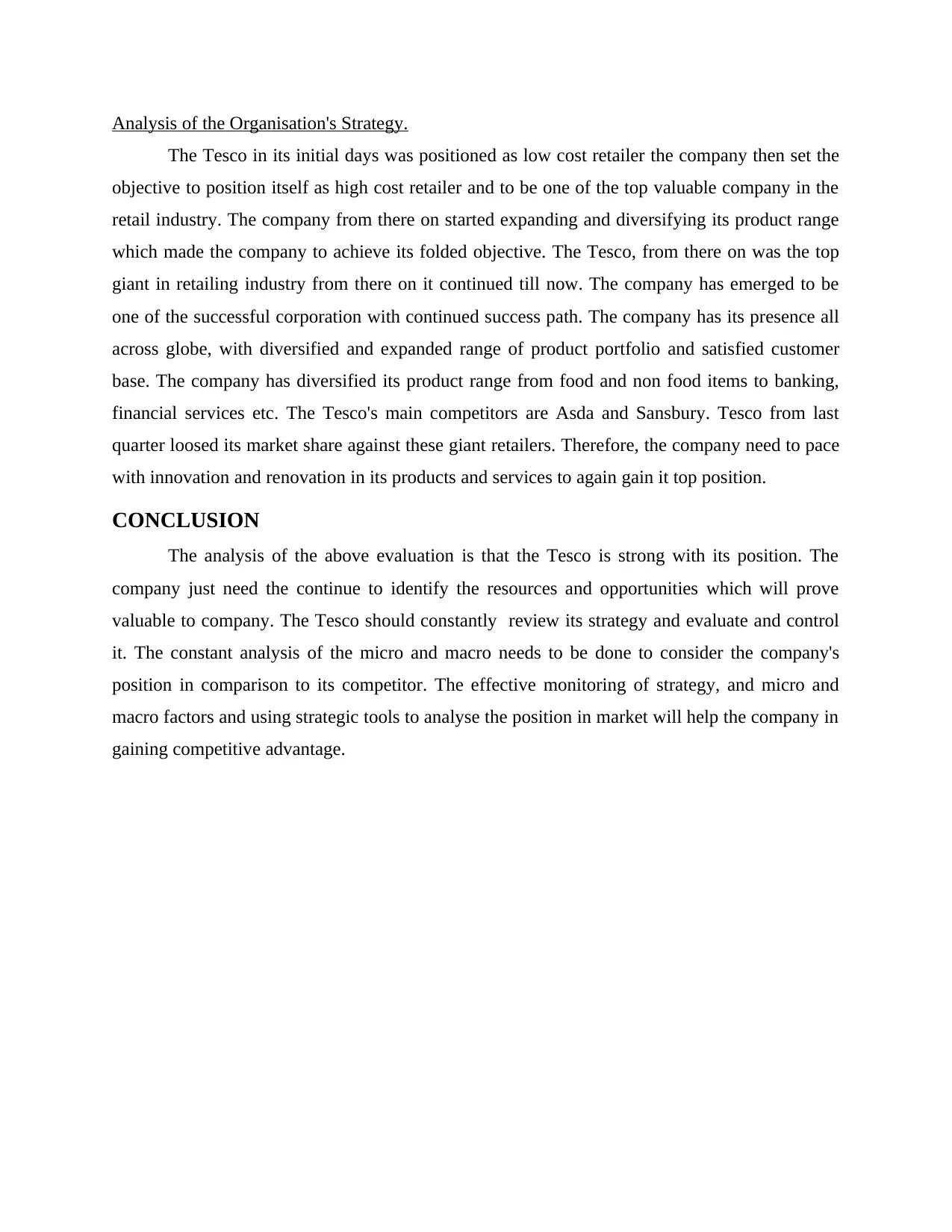
Analysis of the Organisation's Strategy.
The Tesco in its initial days was positioned as low cost retailer the company then set the
objective to position itself as high cost retailer and to be one of the top valuable company in the
retail industry. The company from there on started expanding and diversifying its product range
which made the company to achieve its folded objective. The Tesco, from there on was the top
giant in retailing industry from there on it continued till now. The company has emerged to be
one of the successful corporation with continued success path. The company has its presence all
across globe, with diversified and expanded range of product portfolio and satisfied customer
base. The company has diversified its product range from food and non food items to banking,
financial services etc. The Tesco's main competitors are Asda and Sansbury. Tesco from last
quarter loosed its market share against these giant retailers. Therefore, the company need to pace
with innovation and renovation in its products and services to again gain it top position.
CONCLUSION
The analysis of the above evaluation is that the Tesco is strong with its position. The
company just need the continue to identify the resources and opportunities which will prove
valuable to company. The Tesco should constantly review its strategy and evaluate and control
it. The constant analysis of the micro and macro needs to be done to consider the company's
position in comparison to its competitor. The effective monitoring of strategy, and micro and
macro factors and using strategic tools to analyse the position in market will help the company in
gaining competitive advantage.
The Tesco in its initial days was positioned as low cost retailer the company then set the
objective to position itself as high cost retailer and to be one of the top valuable company in the
retail industry. The company from there on started expanding and diversifying its product range
which made the company to achieve its folded objective. The Tesco, from there on was the top
giant in retailing industry from there on it continued till now. The company has emerged to be
one of the successful corporation with continued success path. The company has its presence all
across globe, with diversified and expanded range of product portfolio and satisfied customer
base. The company has diversified its product range from food and non food items to banking,
financial services etc. The Tesco's main competitors are Asda and Sansbury. Tesco from last
quarter loosed its market share against these giant retailers. Therefore, the company need to pace
with innovation and renovation in its products and services to again gain it top position.
CONCLUSION
The analysis of the above evaluation is that the Tesco is strong with its position. The
company just need the continue to identify the resources and opportunities which will prove
valuable to company. The Tesco should constantly review its strategy and evaluate and control
it. The constant analysis of the micro and macro needs to be done to consider the company's
position in comparison to its competitor. The effective monitoring of strategy, and micro and
macro factors and using strategic tools to analyse the position in market will help the company in
gaining competitive advantage.
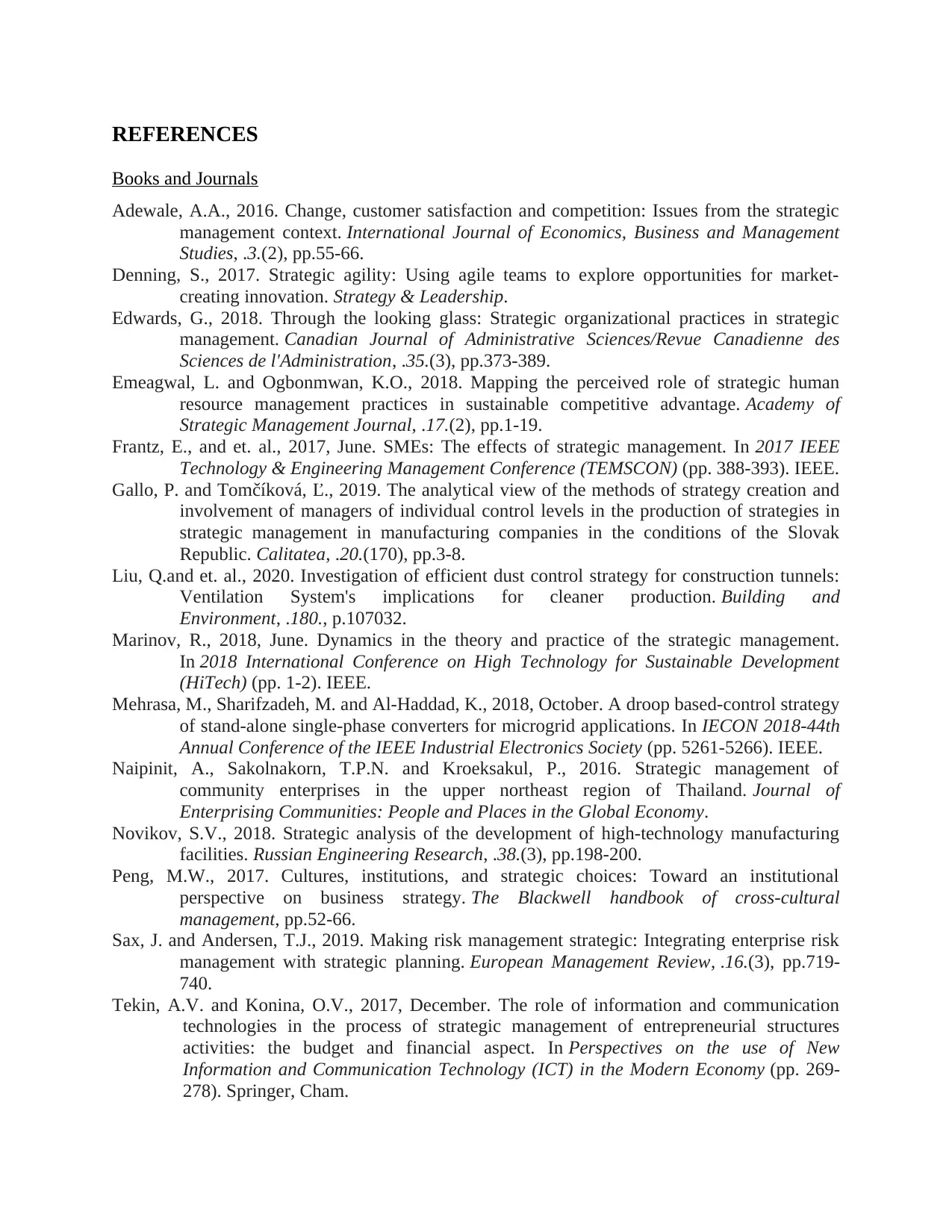
REFERENCES
Books and Journals
Adewale, A.A., 2016. Change, customer satisfaction and competition: Issues from the strategic
management context. International Journal of Economics, Business and Management
Studies, .3.(2), pp.55-66.
Denning, S., 2017. Strategic agility: Using agile teams to explore opportunities for market-
creating innovation. Strategy & Leadership.
Edwards, G., 2018. Through the looking glass: Strategic organizational practices in strategic
management. Canadian Journal of Administrative Sciences/Revue Canadienne des
Sciences de l'Administration, .35.(3), pp.373-389.
Emeagwal, L. and Ogbonmwan, K.O., 2018. Mapping the perceived role of strategic human
resource management practices in sustainable competitive advantage. Academy of
Strategic Management Journal, .17.(2), pp.1-19.
Frantz, E., and et. al., 2017, June. SMEs: The effects of strategic management. In 2017 IEEE
Technology & Engineering Management Conference (TEMSCON) (pp. 388-393). IEEE.
Gallo, P. and Tomčíková, Ľ., 2019. The analytical view of the methods of strategy creation and
involvement of managers of individual control levels in the production of strategies in
strategic management in manufacturing companies in the conditions of the Slovak
Republic. Calitatea, .20.(170), pp.3-8.
Liu, Q.and et. al., 2020. Investigation of efficient dust control strategy for construction tunnels:
Ventilation System's implications for cleaner production. Building and
Environment, .180., p.107032.
Marinov, R., 2018, June. Dynamics in the theory and practice of the strategic management.
In 2018 International Conference on High Technology for Sustainable Development
(HiTech) (pp. 1-2). IEEE.
Mehrasa, M., Sharifzadeh, M. and Al-Haddad, K., 2018, October. A droop based-control strategy
of stand-alone single-phase converters for microgrid applications. In IECON 2018-44th
Annual Conference of the IEEE Industrial Electronics Society (pp. 5261-5266). IEEE.
Naipinit, A., Sakolnakorn, T.P.N. and Kroeksakul, P., 2016. Strategic management of
community enterprises in the upper northeast region of Thailand. Journal of
Enterprising Communities: People and Places in the Global Economy.
Novikov, S.V., 2018. Strategic analysis of the development of high-technology manufacturing
facilities. Russian Engineering Research, .38.(3), pp.198-200.
Peng, M.W., 2017. Cultures, institutions, and strategic choices: Toward an institutional
perspective on business strategy. The Blackwell handbook of cross‐cultural
management, pp.52-66.
Sax, J. and Andersen, T.J., 2019. Making risk management strategic: Integrating enterprise risk
management with strategic planning. European Management Review, .16.(3), pp.719-
740.
Tekin, A.V. and Konina, O.V., 2017, December. The role of information and communication
technologies in the process of strategic management of entrepreneurial structures
activities: the budget and financial aspect. In Perspectives on the use of New
Information and Communication Technology (ICT) in the Modern Economy (pp. 269-
278). Springer, Cham.
Books and Journals
Adewale, A.A., 2016. Change, customer satisfaction and competition: Issues from the strategic
management context. International Journal of Economics, Business and Management
Studies, .3.(2), pp.55-66.
Denning, S., 2017. Strategic agility: Using agile teams to explore opportunities for market-
creating innovation. Strategy & Leadership.
Edwards, G., 2018. Through the looking glass: Strategic organizational practices in strategic
management. Canadian Journal of Administrative Sciences/Revue Canadienne des
Sciences de l'Administration, .35.(3), pp.373-389.
Emeagwal, L. and Ogbonmwan, K.O., 2018. Mapping the perceived role of strategic human
resource management practices in sustainable competitive advantage. Academy of
Strategic Management Journal, .17.(2), pp.1-19.
Frantz, E., and et. al., 2017, June. SMEs: The effects of strategic management. In 2017 IEEE
Technology & Engineering Management Conference (TEMSCON) (pp. 388-393). IEEE.
Gallo, P. and Tomčíková, Ľ., 2019. The analytical view of the methods of strategy creation and
involvement of managers of individual control levels in the production of strategies in
strategic management in manufacturing companies in the conditions of the Slovak
Republic. Calitatea, .20.(170), pp.3-8.
Liu, Q.and et. al., 2020. Investigation of efficient dust control strategy for construction tunnels:
Ventilation System's implications for cleaner production. Building and
Environment, .180., p.107032.
Marinov, R., 2018, June. Dynamics in the theory and practice of the strategic management.
In 2018 International Conference on High Technology for Sustainable Development
(HiTech) (pp. 1-2). IEEE.
Mehrasa, M., Sharifzadeh, M. and Al-Haddad, K., 2018, October. A droop based-control strategy
of stand-alone single-phase converters for microgrid applications. In IECON 2018-44th
Annual Conference of the IEEE Industrial Electronics Society (pp. 5261-5266). IEEE.
Naipinit, A., Sakolnakorn, T.P.N. and Kroeksakul, P., 2016. Strategic management of
community enterprises in the upper northeast region of Thailand. Journal of
Enterprising Communities: People and Places in the Global Economy.
Novikov, S.V., 2018. Strategic analysis of the development of high-technology manufacturing
facilities. Russian Engineering Research, .38.(3), pp.198-200.
Peng, M.W., 2017. Cultures, institutions, and strategic choices: Toward an institutional
perspective on business strategy. The Blackwell handbook of cross‐cultural
management, pp.52-66.
Sax, J. and Andersen, T.J., 2019. Making risk management strategic: Integrating enterprise risk
management with strategic planning. European Management Review, .16.(3), pp.719-
740.
Tekin, A.V. and Konina, O.V., 2017, December. The role of information and communication
technologies in the process of strategic management of entrepreneurial structures
activities: the budget and financial aspect. In Perspectives on the use of New
Information and Communication Technology (ICT) in the Modern Economy (pp. 269-
278). Springer, Cham.
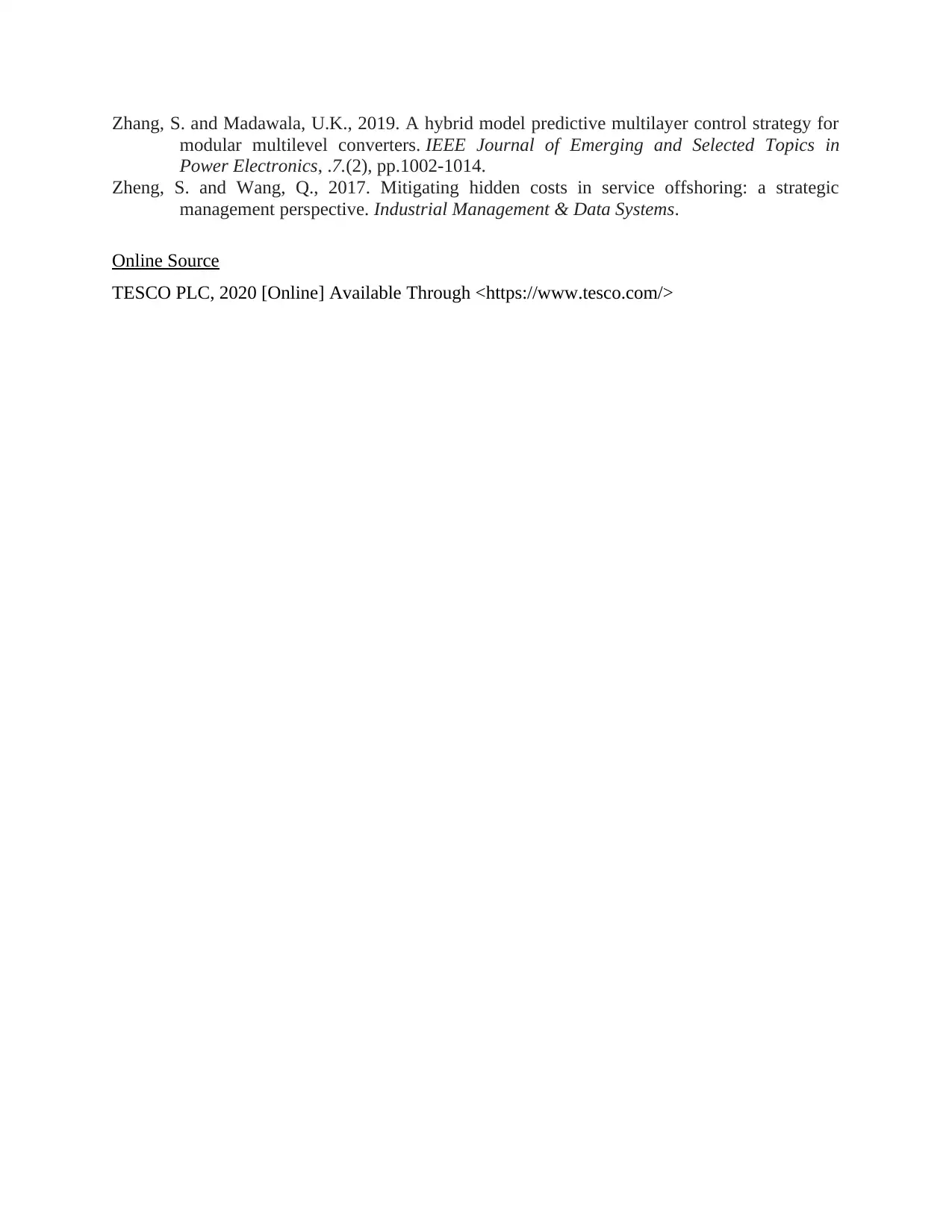
Zhang, S. and Madawala, U.K., 2019. A hybrid model predictive multilayer control strategy for
modular multilevel converters. IEEE Journal of Emerging and Selected Topics in
Power Electronics, .7.(2), pp.1002-1014.
Zheng, S. and Wang, Q., 2017. Mitigating hidden costs in service offshoring: a strategic
management perspective. Industrial Management & Data Systems.
Online Source
TESCO PLC, 2020 [Online] Available Through <https://www.tesco.com/>
modular multilevel converters. IEEE Journal of Emerging and Selected Topics in
Power Electronics, .7.(2), pp.1002-1014.
Zheng, S. and Wang, Q., 2017. Mitigating hidden costs in service offshoring: a strategic
management perspective. Industrial Management & Data Systems.
Online Source
TESCO PLC, 2020 [Online] Available Through <https://www.tesco.com/>
Secure Best Marks with AI Grader
Need help grading? Try our AI Grader for instant feedback on your assignments.

1 out of 14
Related Documents
Your All-in-One AI-Powered Toolkit for Academic Success.
+13062052269
info@desklib.com
Available 24*7 on WhatsApp / Email
![[object Object]](/_next/static/media/star-bottom.7253800d.svg)
Unlock your academic potential
© 2024 | Zucol Services PVT LTD | All rights reserved.





